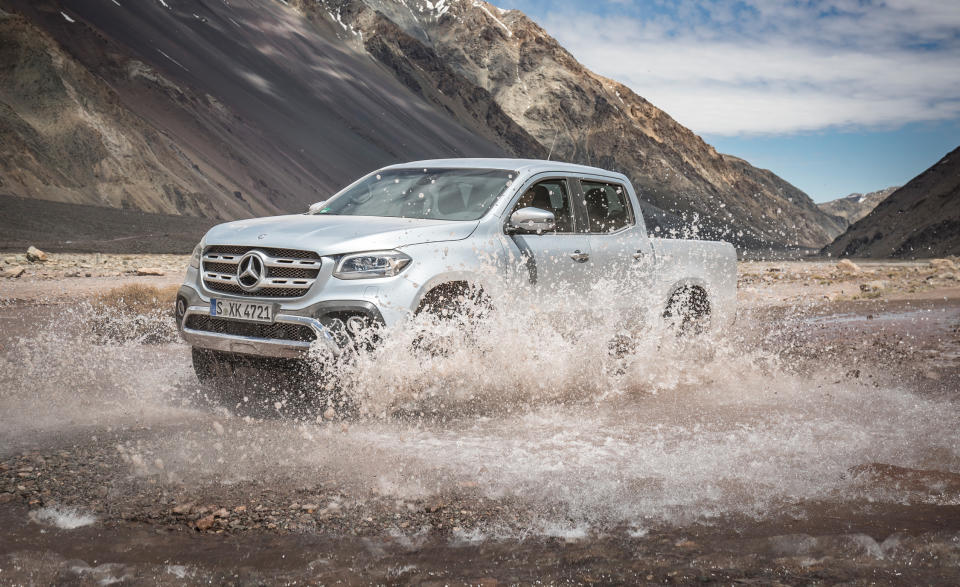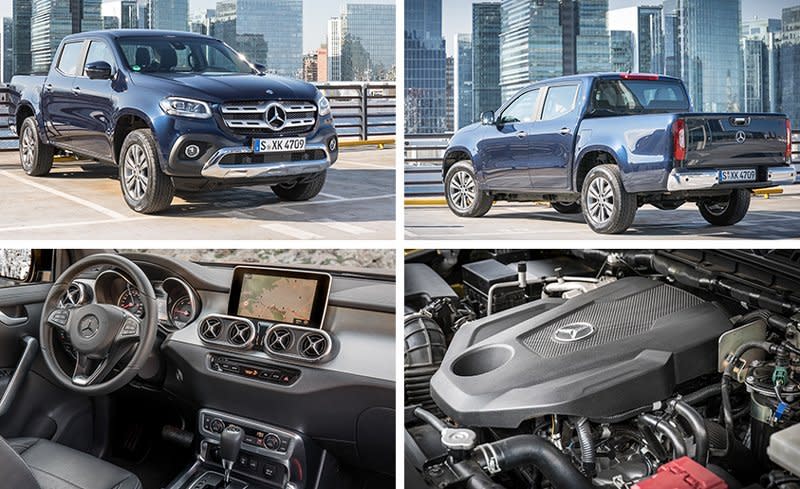2018 Mercedes-Benz X-class Pickup

Expectations could hardly be higher than when Mercedes-Benz, the brand with the motto “The best or nothing,” sets out to enter a market segment. After years of choosing “nothing” as it regards vehicles with a cargo bed at the back, and following years of intensive market research, soul searching, and development, the new X-class pickup truck has arrived.
Mercedes—whose corporate parent Daimler has a rich history as a maker of commercial trucks—didn’t try to reinvent the wheel in creating its first ever pickup, nor did its engineers take a GLE-class SUV and add a pickup bed. Instead, they drew from corporate partner Nissan and its Europe-market Navara—the successor to the Frontier that Nissan still sells in the United States. The Nissan pickup has a reputation for toughness and reliability, and the latest Navara replaced the traditional leaf springs for the rear axle with coil springs. That was key to enabling the kind of handling and ride comfort that Daimler had in mind. The mid-size X-class needs to be a tough workhorse just as much as a comfortable long-distance cruiser.

The finished X-class shares its ladder frame and a number of nonvisible parts with the Nissan, but hunting for obvious similarities turned out to be frustrating (or encouraging, depending on how you look at it). The X-class is a very different vehicle, but it won’t be offered in the U.S., the world’s most competitive pickup-truck market.
Wider and Higher
If it looks more substantial than the Nissan, that’s because Daimler has widened the track—and the bodywork—by a full 2.8 inches. The two trucks will be built on the same assembly lines, but no exterior sheetmetal or glass is interchangeable. The door geometry—the hinges, latches, and their locations—is the same, but the panels are all brand-specific.
The X-class looks good, with a front end dominated by the large three-pointed star and an overall design similar to Benz’s SUV models. The rear end with its slim vertical taillights reminds us of a concept car, especially when fitted with the LED front and rear lighting that comes with upper trim levels.

The widened body allows more generous interior space than the Navara offers. Mercedes has raised the rear-seat bottom to deliver more comfort—in the rear of the Nissan, you can feel like a half-folded pocketknife—although tall adults will lack for headroom. There is a lot more sound insulation than in the Nissan, and the Germans have added structural elements to the frame in order to reduce noise, vibrations, and harshness.
The interior is dominated by a concave dashboard; the instruments, central screen, HVAC controls, and the optional, touch-sensitive COMAND infotainment system come straight from the Mercedes-Benz passenger car parts bin. In the standard trim, called Pure, the look is somewhat frugal with a lot of hard plastic, but most of the electronic goodies are aboard, including the latest driver-assistance safety systems. The mid-level Progressive trim brings a bit more fabric to the cabin as well as exterior niceties like body-color bumpers. But it takes the top-of-the-line Power trim to give the X-class the appearance of an upmarket vehicle, with stitched faux leather applied to the dashboard and inner door panels. Aluminum and wood trim are options.
The X-class falls short of its premium aspirations when carryover parts from Nissan are used. These include the dome light, the switches for the seat heaters, and, we suspect, the automatic gear selector that sprouts from the console. The X-class also needs far more storage in the cabin, where only the door pockets are sufficiently large—the center console bin, the cup holders, and the glovebox are all tiny.

All Turbo-Diesel, All the Time
We drove the X250d 4Matic, which is rated at 187 horsepower and 332 lb-ft from its Nissan-built sequentially turbocharged 2.3-liter diesel inline-four. The entry-level X220d, which was not made available to drive, has a similar four but with only one turbocharger and is rated at 161 horsepower and 297 lb-ft of torque. Both engines come with a six-speed manual as standard, but a Nissan-built seven-speed automatic is available with both engines (and is standard on higher trims). With the automatic transmission and optional all-wheel-drive system, the X250d will reach 62 mph in a somewhat leisurely 11.8 seconds and top out at 109 mph, by Daimler’s reckoning.
The dual turbo usually needs a moment to react to driver input, and it sounds a bit strained under full throttle. The power-sapping automatic is not particularly quick to respond, either, so it is best to restrain your aspirations and just go with the flow of traffic. Then you can enjoy the comfy ride and the remarkably well-isolated cabin.
There was a stick-shift X250d on hand, and while that six-speed gearbox is based on a Nissan design, Daimler developed a cable-linkage system exclusively for the X-class. The effect is clearly noticeable: There is absolutely no vibration in the shifter, and except for its long throws, the gearbox could pass for a passenger car’s. The manual beats the automatic, hands down. (A few select markets, by the way, will see an entry-level X-class with a manual gearbox, rear-wheel drive, and a naturally aspirated 2.0-liter gasoline engine.)

The chassis is capable of dealing with the worst off-road conditions, but it is also comfortable and surprisingly capable of spirited on-road driving. The limits of adhesion are higher than the competition’s, and it’s possible to move the tail around a bit if you feel so compelled, although the X-class’s stability control will frown upon the exercise and intervene promptly. The steering is good for a pickup, not as overboosted as on most other trucks, but don’t expect the X-class to reach even SUV standards for handling prowess. There is considerable body roll, too.
Need More Grunt? Wait for It
More power will be available via the X350d 4Matic that is slated for a 2018 calendar year launch and fitted with Mercedes’ own, smooth turbo-diesel 3.0-liter V-6 and seven-speed automatic with shift paddles. It will also offer several driving modes and permanent all-wheel drive. Rated at 254 horsepower and 406 lb-ft, the V-6 should easily allow for zero-to-60-mph times below nine seconds and a terminal velocity beyond 125 mph. We weren’t allowed to drive this model, but we did catch a ride in one on closed roads at a surreal pace; the X350d stands poised to offer the most fun you can have in a pickup of this size—if you live in Europe.
At more than €37,000 in its German home market (a figure that includes a 19 percent sales tax, so call it $37,000 or so pre-tax) the Mercedes-Benz X-class isn’t cheap. Adding the twin-turbo engine, automatic transmission, and all-wheel drive puts an extra €4500 on the tab, and that’s for the base Pure model. It’s a big chunk of change above every other pickup in its class, and it even eclipses the Volkswagen Amarok with its standard V-6 TDI engine. But the price looks more reasonable when you factor in the assistance and telematics systems, which no other European pickup offers. A U.S.-market launch is off the table for now; depending on sales volumes in the burgeoning mid-size pickup segment, the company might reconsider. If it does make it here, it won’t be cheap, but it will be the Mercedes-Benz of pickup trucks.
Specifications >
VEHICLE TYPE: front-engine, all-wheel-drive, 5-passenger, 4-door pickup
ESTIMATED BASE PRICE (Germany): X250d 4Matic, $41,500
ENGINE TYPE: sequentially turbocharged and intercooled DOHC 16-valve diesel inline-4, iron block and aluminum head, direct fuel injection
Displacement: 183 cu in, 2299 cc
Power: 187 hp @ 3750 rpm
Torque: 332 lb-ft @ 1500 rpm
TRANSMISSION: 7-speed automatic with manual shifting mode
DIMENSIONS:
Wheelbase: 124.0 in
Length: 210.2 in
Width: 75.6 in Height: 71.6 in
Curb weight (C/D est): 4950 lb
PERFORMANCE (C/D EST):
Zero to 60 mph: 10.0 sec
Zero to 100 mph: 34.0 sec
Standing ¼-mile: 17.9 sec
Top speed: 108 mph
EPA FUEL ECONOMY (C/D EST):
Combined/city/highway: 23/20/28 mpg

 Yahoo Autos
Yahoo Autos 